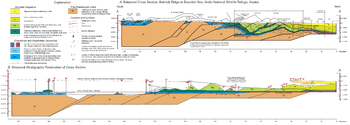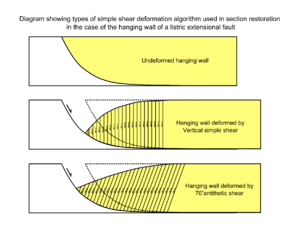Section restoration

In structural geology section restoration or palinspastic restoration is a technique used to progressively undeform a geological section in an attempt to validate the interpretation used to build the section. It is also used to provide insights into the geometry of earlier stages of the geological development of an area. A section that can be successfully undeformed to a geologically reasonable geometry, without change in area, is known as a balanced section.[1]
Comparably a palinspastic map is a map view of geological features, often also including present-day coastlines to aid the reader in recognising the area, representing the state before deformation.
2D restoration
Development of technique
The earliest attempts to produce restored sections were on foreland fold and thrust belts.[2] This technique assumed a stratigraphic template with unit thicknesses either constant or smoothly varying across the section. Line lengths were measured on the present-day deformed section and transferred to the template, to rebuild the section as it was before deformation started. This method does not guarantee that area is conserved, only line length. The technique was applied to areas of extensional tectonics initially using vertical simple shear.[3][4] Over the next decade several types of commercial restoration software became available, allowing the technique to be routinely applied.
Deformation algorithms

In order to calculate the change in shape of an element within the section, various deformation algorithms are used. Initially many of these were applied manually, but are now available in specialist software packages. It is worth mentioning that these deformation algorithms are approximations and idealizations of actual strain paths and deviate from reality (Ramsey and Huber, 1987). Geologic media are typically not continuum materials; that is, they are not isotropic media as is implicitly assumed in all strain algorithms used for cross-section balancing. That said, balanced cross sections maintain material balance, which is important for conceptualizing kinematic histories of deformed regions.
Vertical/inclined shear
This mechanism deforms an element to accommodate a change in shape by movement on closely spaced parallel planes of slip. The commonest assumption is vertical shear although comparisons with well understood examples suggest that antithetic inclined shear (i.e. in the opposite sense of dip to the controlling fault) at about 60°–70° is the best approximation to the behaviour of real rocks under extension.[5][6] These algorithms preserve area but do not, in general, preserve line length. Restoration using this type of algorithm can be carried out by hand, but is normally done using specialist software. This algorithm is not generally thought to represent the actual mechanism by which deformation occurs, just to represent a reasonable approximation.
Flexural slip
In a flexural slip algorithm deformation occurs by unfolding the deformed fault bounded horse by slip along bedding planes.[1] This modelling mechanism does represent a real geological mechanism, as shown by slickensides along folded bedding planes.[7] The shape of the unfolded horse is further constrained either by using the restored fault boundary to the previous horse in the restored section of by using an internal pin within the block itself, assuming this was unsheared during the deformation. This algorithm is normally only used in software based restoration. It preserves both area and line length.
Trishear
A trishear algorithm is used to model and restore fault-propagation folds as other algorithms fail to explain thickness changes and strain variations associate with such folds. The deformation within the tip-zone of the propagating fault is idealised to heterogeneous shear within a triangular zone starting at the fault tip.[8]
Compaction
In most section restorations there is an element of backstripping and decompaction. This is necessary to adjust the geometry of the section for the compactional effects of later sediment loading.[9]
Forward modelling
Section restoration involves undeforming a natural example, a form of inverse modelling.[10] In many cases carrying out forward modelling helps to test out concepts for all or part of the section.
3D restoration
A basic assumption of 2D restoration is that the displacement on all faults is within the plane of the section. It also assumes that no material enters or leaves the section plane. In areas of complex multi-phase or strike slip deformation or where salt is present, this is rarely the case. 3D restoration can only be carried out using specialist software, such as Midland Valley's Move3D, Paradigm's Kine3D or Schlumberger's Dynel3D. The results of such restoration can be used to study the migration of hydrocarbons at an earlier stage.[11]
References
- 1 2 Groshong, R. (2006). "Structural Validation, Restoration and Prediction". 3-D structural geology: a practical guide to quantitative surface and subsurface map interpretation. Birkhäuser. pp. 305–372. ISBN 978-3-540-31054-9. Retrieved 2010-02-20.
- ↑ Bally, A.W.; Gordy P.L.; Stewart G.A. (1966). "Structure, seismic data and orogenic evolution of Southern Canadian Rocky Mountains". Bulletin of Canadian Petroleum Geology. 14: 337–381.
- ↑ Gibbs, A.D. (1983). "Balanced cross-section construction from seismic sections in areas of extensional tectonics". Journal of Structural Geology. 5 (2): 153–160. Bibcode:1983JSG.....5..153G. doi:10.1016/0191-8141(83)90040-8.
- ↑ Williams, G.; Vann I. (1987). "The geometry of listric normal faults and deformation in their hanging walls". Journal of Structural Geology. 9 (7): 789–795. Bibcode:1987JSG.....9..789W. doi:10.1016/0191-8141(87)90080-0.
- ↑ Hauge, T.A.; Gray G.G. (1996). "A critique of techniques for modelling normal-fault and rollover geometries". In Buchanan P.G. & Nieuwland D.A. Modern Developments in Structural Interpretation, Validation and Modelling. Special Publications. 99. Geological Society, London. pp. 89–97. Retrieved 2010-02-09.
- ↑ Withjack, M.O.; Schlische R.W. (2006). "Geometric and experimental models of extensional fault-bend folds". In Buiter S.J.H. & Schreurs G. Analogue and Numerical Modelling of Crustal-Scale Processes (PDF). Special Publications. 253. Geological Society, London. pp. 285–305. Retrieved 2010-02-09.
- ↑ Faill, R.T. (1973). "Kink-Band Folding, Valley and Ridge Province, Pennsylvania". Bulletin Geological Society of America. 84 (4): 1289–1314. Bibcode:1973GSAB...84.1289F. doi:10.1130/0016-7606(1973)84<1289:KFVARP>2.0.CO;2. Retrieved 2010-02-20.
- ↑ Erslev, E.A. (1991). "Trishear fault-propagation folding". Geology. 19 (6): 617–620. Bibcode:1991Geo....19..617E. doi:10.1130/0091-7613(1991)019<0617:TFPF>2.3.CO;2. Retrieved 2010-02-20.
- ↑ Skuce, A.G. (1996). "Forward modelling of compaction above normal faults: an example from the Sirte Basin, Libya". In Buchanan P.G. and Nieuwland D.A. Modern Developments in Structural Interpretation, Validation and Modelling. Special Publications. 99. London: Geological Society. pp. 135–146. Retrieved 2010-02-20.
- ↑ Poblet, J.; Bulnes M. (2007). "Predicting strain using forward modelling of restored cross-sections: Application to rollover anticlines over listric normal faults". Journal of Structural Geology. 29 (12): 1960–1970. Bibcode:2007JSG....29.1960P. doi:10.1016/j.jsg.2007.08.003.
- ↑ Clarke, S.M.; Burley S.D.; Williams G.D.; Richards A.J.; Meredith D.J.; Egan S.S. (2006). "Integrated four-dimensional modelling of sedimentary basin architecture and hydrocarbon migration". In Buiter S.J.H. & Schreurs G. Analogue and Numerical Modelling of Crustal-Scale Processes. Special Publications. 253. Geological Society, London. pp. 185–211. ISBN 978-1-86239-191-8. Retrieved 2010-02-20.